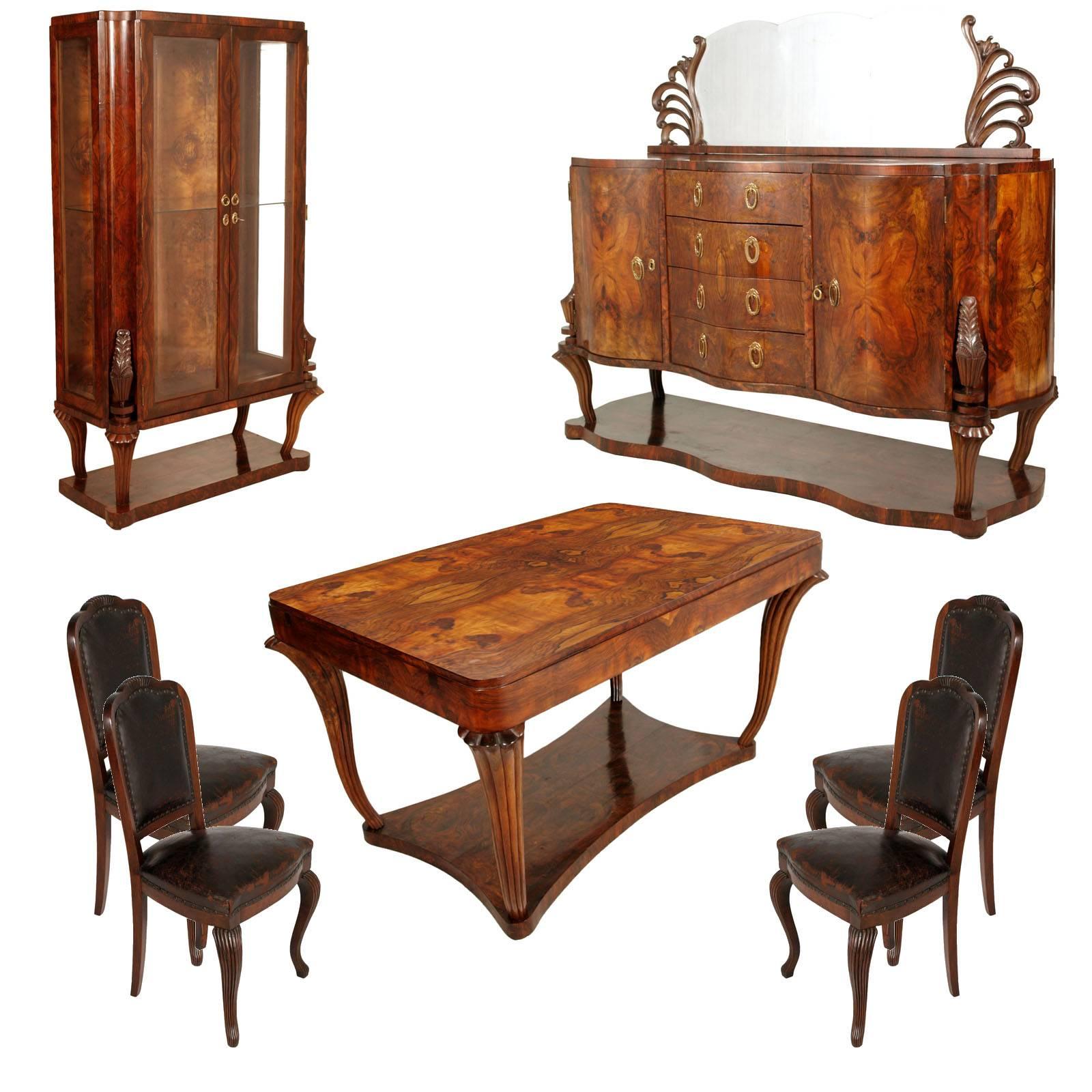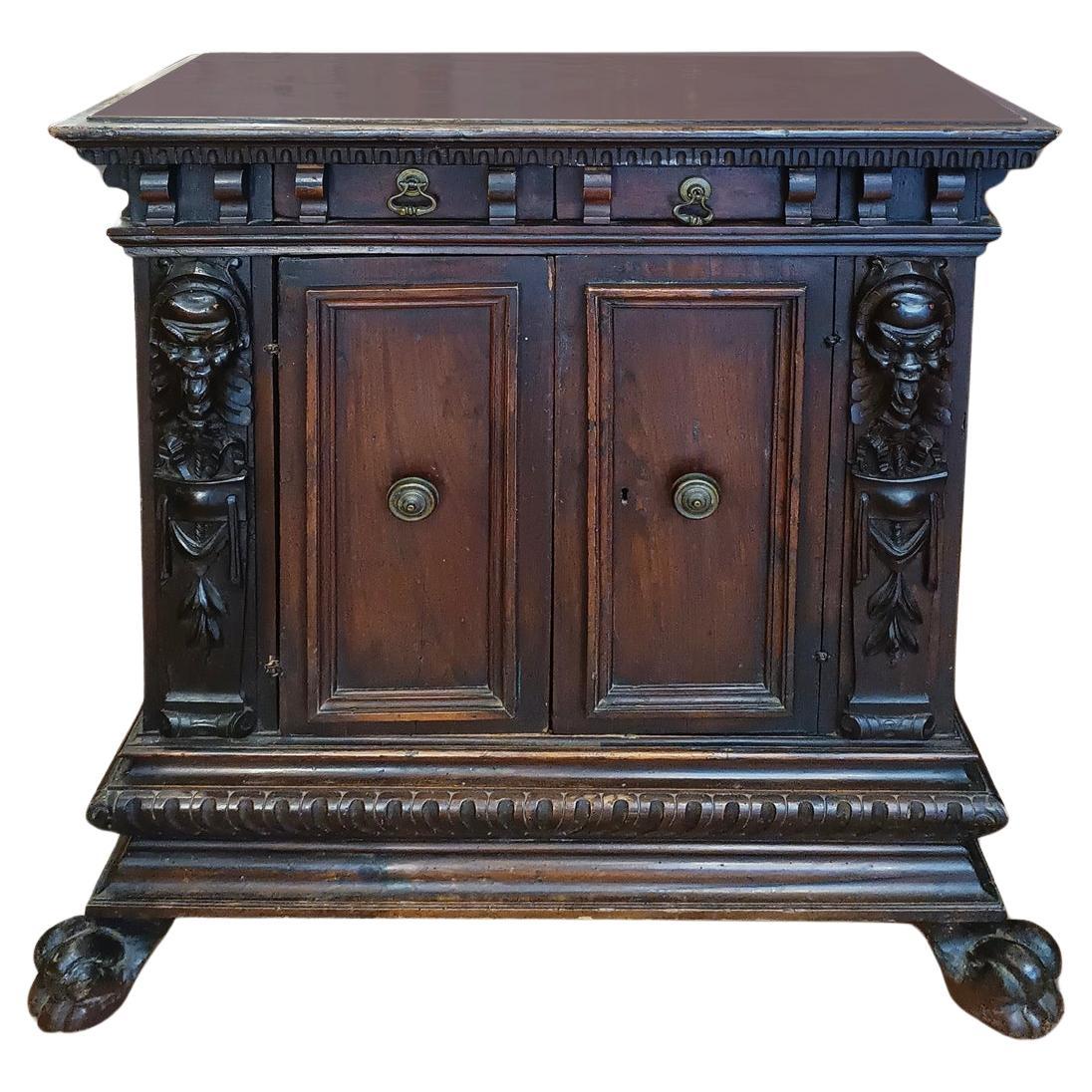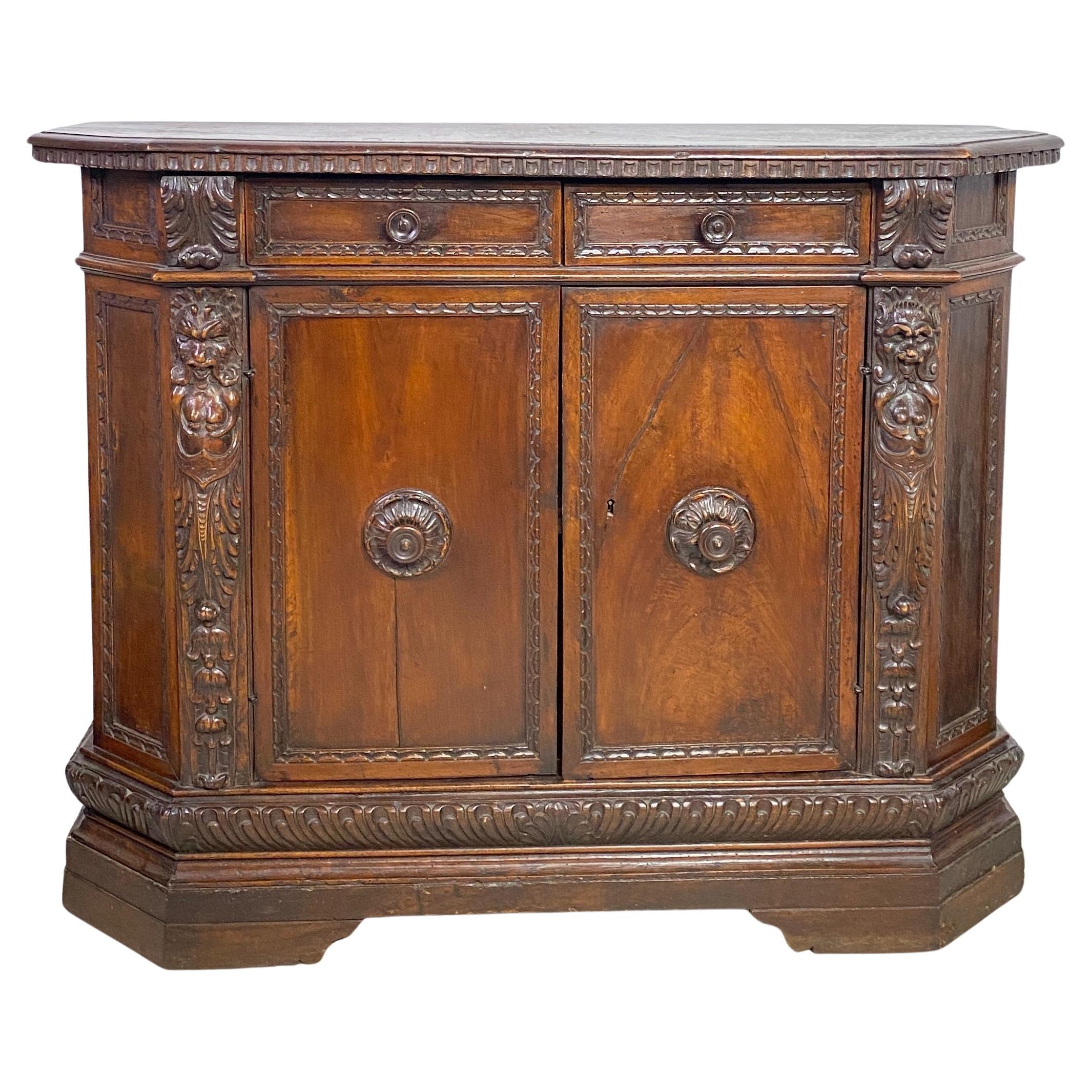Items Similar to 18th Century Renaissance Palladio Dining Room Set in blackening wood of walnut
Want more images or videos?
Request additional images or videos from the seller
1 of 21
18th Century Renaissance Palladio Dining Room Set in blackening wood of walnut
About the Item
Monumental and important Renaissance Palladio dining room set all in solid hand-carved walnut from a Palladian Palace in Vicenza of a Venetian patrician family.
The back of the showcase was rebuilt again at the end of the 800 first 900 with the application of damask fabric
The table can be extended up to 4-6 meters
The large sideboard and the display cabinet are in the process of conservative restoration and have therefore been disassembled, as seen from the last photos.
Measures in cm:
Sideboard H 240 x L 315 x D 70
Display cabinet H 240 x L 230 x D 60
Table H 78 L x 230 x D 140 Extendable to 4-6 meters
Notes:
The architectural design of Andrea Palladio, thanks to his followers, gave its name to a style – the Palladian style, that adheres to the principles of Classical Roman. Among his disciples, Vincenzo Scamozzi which, in the homeland, completed several works by the master. The Palladian style was successful until the nineteenth century. The architecture of Palladio soon became famous not only in Italy but throughout Europe. Andrea Palladio was recognized as the forerunner of the neoclassical and, with his style, he inspired English architects, as Inigo Jones and Christopher Wren. Another of his famous admirer was the architect Richard Boyle, known as Lord Burlington which – with William Kent – designed Chiswick House. The White House in Washington, residence of the President of the United States of America, is designed in the Palladian style.
Andrea Palladio, nicknamed Andrea di Pietro della Gondola (Padua, November 30, 1508 - Maser, August 19, 1580), was an architect, theoretician of the Italian Renaissance architect and set designer, a citizen of the Republic of Venice. Influenced by Greek-Roman architecture, first of all by Vitruvio, it is considered one of the most influential personalities in the history of Western architecture.
He was the most important architect of the Republic of Venice, in whose territory he designed many villas that made him famous, as well as churches and palaces, mostly Vicenza, where he formed and lived. He published the treatise The Four Books of Architecture (1570) through which his models had a profound influence on Western architecture; The imitation of his style gave rise to a movement destined to last for three centuries, Palladianism, which recalls the classical-Roman principles. The city of Vicenza and the Palladian villas of Veneto are one of the UNESCO World Heritage Sites.
- Similar to:Andrea Palladio (Designer)
- Dimensions:Height: 157.49 in (400 cm)Width: 157.49 in (400 cm)Depth: 157.49 in (400 cm)Seat Height: 157.49 in (400 cm)
- Sold As:Set of 3
- Style:Renaissance (Of the Period)
- Materials and Techniques:
- Place of Origin:
- Period:
- Date of Manufacture:1770-1790
- Condition:Wear consistent with age and use.
- Seller Location:Vigonza, IT
- Reference Number:
About the Seller
4.9
Vetted Seller
These experienced sellers undergo a comprehensive evaluation by our team of in-house experts.
Established in 2017
1stDibs seller since 2017
Typical response time: 3 hours
- ShippingRetrieving quote...Ships From: Vigonza, Italy
- Return PolicyThis item cannot be returned.
More From This SellerView All
- 18th Century Important Tuscany Renaissance Sideboard Credenza, in Solid WalnutLocated in Vigonza, PaduaCode: FR45 Antique Tuscany heavy and massive sideboard in solid walnut. In two parts: the top with two doors and two internal shelves with spiral wal...Category
Antique Mid-18th Century Italian Renaissance Sideboards
MaterialsWalnut
- 1920s Art Deco Dining Room Set, Table Chairs Sideboard, Venice Baroque, walnutBy Testolini & SalviatiLocated in Vigonza, PaduaWe can sell the pieces separately Spectacular early 20th century Art Deco complete dining room by Testolini & Salviati -Venice in burl walnut and hand-carved massive walnut , polishe...Category
Early 20th Century Italian Art Deco Dining Room Sets
MaterialsBronze
- Italian Renaissance Style Set Dining Room 16 Pieces Walnut Hand-CarvedLocated in Vigonza, PaduaCode: FQ58 Period: 19th century Style: Renaissance Dining room of the School of Arts in Monza, 19th century, walnut hand-carved consists of: sideboard showcase with leaded cathedral glass; sideboard with central mirror; console with large mirror; table with 12 chairs lined leather. Measures cm (height, length, depth): sideboard with showcase...Category
Antique 19th Century Italian Renaissance Dining Room Sets
MaterialsLeather, Glass, Walnut
- Italy Art Deco Dining Room Set, table, chairs & sideboards, by Osvaldo BorsaniBy Osvaldo BorsaniLocated in Vigonza, PaduaThey can be sold separately 1930s amazing dining room in burl walnut flame applied with particular edge to 45 degrees, the furniture industry "Guido Pennati", design attributed to Os...Category
Vintage 1920s Italian Art Deco Dining Room Sets
MaterialsVelvet, Mirror, Walnut, Burl
- Late 19th Century Renaissance Sideboard Hand-Carved Walnut by G. ScalambrinLocated in Vigonza, PaduaCode: FG33 Antique Renaissance sideboard buffet in two parts late 19th century hand-carved massive walnut by Giuseppe Scalambrin. Six doors with ...Category
Antique Late 19th Century Italian Renaissance Revival Credenzas
MaterialsWalnut
- Tyrolean Late 18th Century Credenza Sideboard Massive Chestnut Wood Wax PolishedLocated in Vigonza, PaduaExceptional charming antique Tyrolean handmade sideboard , in precious chestnut wood with gilded brass closing handles. The beauty and patina of this ...Category
Antique Late 18th Century Austrian Country Credenzas
MaterialsChestnut
You May Also Like
- 18th Century Italian Carved Walnut CabinetLocated in Forney, TXA rare 18th century Italian walnut chest / credenza, Renaissance Period, neoclassical influenced, having two elaborately carved figural statue c...Category
Antique 18th Century Renaissance Credenzas
MaterialsOrmolu
- 16th CENTURY RENAISSANCE SMALL SIDEBOARD IN SOLID WALNUTLocated in Firenze, FIElegant Renaissance small sideboard, made entirely of solid walnut by Florentine artisans and dating back to the first half of the 16th century. Its structure is composed of two fron...Category
Antique 16th Century Italian Renaissance Credenzas
MaterialsWood, Nutwood
- 16th CENTURY RENAISSANCE SMALL SIDEBOARD IN SOLID WALNUTLocated in Firenze, FIElegant sideboard in solid walnut wood with dark patina, small but refined in size. The cabinet is equipped with two doors and two drawers, with turned and lost wax cast bronze handl...Category
Antique 16th Century Italian Renaissance Credenzas
MaterialsNutwood
- 17th Century Walnut Italian Renaissance CredenzaLocated in San Francisco, CAAn extraordinary Tuscan Renaissance period walnut credenza in superb original condition. Hand carved, warm rich original patina, having two drawers and a single interior shelf. Italy...Category
Antique 17th Century Italian Renaissance Credenzas
MaterialsWalnut
- Louis XIV Buffet in Walnut, 18th CenturyLocated in Brussels, Brusselssuperb Louis XIV walnut sideboard from the beginning of the 18th century from France Very elegant credenza or buffet which opens with two large molded doors with symmetrical carvi...Category
Antique 18th Century French Louis XIV Buffets
MaterialsWalnut
- 16th Century Period Renaissance Tuscan Walnut CredenzinoLocated in Vero Beach, FL16th Century Period Renaissance Tuscan Walnut Credenzino Italian 16th/17th century Renaissance walnut small Credenza with a rectangular top above a single drawer centered over a s...Category
Antique 16th Century Italian Renaissance Credenzas
MaterialsWalnut
Recently Viewed
View AllMore Ways To Browse
Italian Carved Dining Room
Antique Walnut Dining Room Furniture
Set Of Three Tables
Antique Tables Dining Tables And Sets
Antique Furniture Dining Tables And Sets
Antique Dining Room Dining Tables And Sets
Antique Pine Dining Table
Antique Pine Dining Tables
Pine Antique Dining Table
Antique Pine Dining Room Table
Antique Solid Wood Dining Room
Antique Hand Made Dining Table
Antique European Dining Table
Antique American Dining Table
American Antique Dining Tables
Ebonized Wood Dining Table
Antique Style Table Set
English Wood Dining Table





